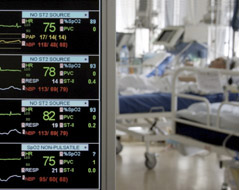What is sepsis?
Sepsis is a serious medical condition caused by an overwhelming immune response to infection. Immune chemicals released into the blood to combat the infection trigger widespread inflammation, which leads to blood clots and leaky vessels. This results in impaired blood flow, which damages the body’s organs by depriving them of nutrients and oxygen.
In severe cases, one or more organs fail. In the worst cases, blood pressure drops, the heart weakens and the patient spirals toward septic shock. Once this happens, multiple organs—lungs, kidneys, liver—may quickly fail and the patient can die.
Sepsis is a major challenge in the intensive care unit, where it’s one of the leading causes of death. It arises unpredictably and can progress rapidly.
What causes sepsis?
 Sepsis does not arise on its own. It stems from another medical condition such as an infection in the lungs, urinary tract, skin, abdomen (such as appendicitis) or other part of the body. Invasive medical procedures like the insertion of a vascular catheter can introduce bacteria into the bloodstream and bring on the condition.
Sepsis does not arise on its own. It stems from another medical condition such as an infection in the lungs, urinary tract, skin, abdomen (such as appendicitis) or other part of the body. Invasive medical procedures like the insertion of a vascular catheter can introduce bacteria into the bloodstream and bring on the condition.
Many different types of microbes can cause sepsis, including bacteria, fungi and viruses, but bacteria are the most common culprits. Severe cases often result from a body-wide infection that spreads through the bloodstream, but sepsis can also stem from a localized infection.
Who gets sepsis?
Anyone can get sepsis, but people with weakened immune systems, children, infants and the elderly are most vulnerable. People with chronic illnesses, such as diabetes, AIDS, cancer and kidney or liver disease are also at increased risk, as are those who have experienced a severe burn or physical trauma.
How many people get sepsis?
Every year, severe sepsis strikes about 750,000 Americans1. It’s been estimated that between 28 and 50 percent of these people die2—far more than the number of U.S. deaths from prostate cancer, breast cancer and AIDS combined.
The number of sepsis cases per year has been on the rise in the United States. This may be due to an aging population, the increased longevity of people with chronic diseases, the spread of antibiotic-resistant organisms, an upsurge in invasive procedures and broader use of immunosuppressive and chemotherapeutic agents.
What are the symptoms of sepsis?
Common symptoms of sepsis are fever, chills, rapid breathing and heart rate, rash, confusion and disorientation. Many of these symptoms, such as fever and difficulty breathing, mimic other conditions, making sepsis hard to diagnose in its early stages.
How is sepsis diagnosed?
A blood test is typically performed to reveal if the number of white blood cells is abnormal, a common sign of the condition. Blood and other bodily fluids such as urine and sputum are also usually tested for the presence of infectious agents.
In addition, a chest X-ray or a CT scan can help identify the site of infection.
 How is sepsis treated?
How is sepsis treated?
People with sepsis are usually treated in hospital intensive care units. Doctors try to quell the infection, sustain the vital organs and prevent a drop in blood pressure.
The first step is often treatment with broad-spectrum antibiotics, medicines that kill many types of bacteria. Once lab tests identify the infectious agent, doctors can select medicine that specifically targets the microbe. Many patients receive oxygen and intravenous fluids to maintain normal blood oxygen levels and blood pressure.
Depending on the patient’s status, other types of treatment, such as mechanical ventilation or kidney dialysis, may be necessary. Sometimes, surgery is required to clear a local site of infection.
Many other drugs, including vasopressors and corticosteroids, may be used to treat sepsis or to revive those who have gone into septic shock. Despite years of research, scientists have not yet succeeded in developing a medicine that specifically targets the aggressive immune response that characterizes sepsis.
Are there any long-term effects of sepsis?
 Many people who survive severe sepsis recover completely and their lives return to normal. But some people, especially those who had pre-existing chronic diseases, may experience permanent organ damage. For example, in someone who already has kidney impairment, sepsis can lead to kidney failure that requires lifelong dialysis.
Many people who survive severe sepsis recover completely and their lives return to normal. But some people, especially those who had pre-existing chronic diseases, may experience permanent organ damage. For example, in someone who already has kidney impairment, sepsis can lead to kidney failure that requires lifelong dialysis.
There is also some evidence that an episode of severe sepsis disrupts a person’s immune system, making him or her more vulnerable to future infections. Studies have shown that people who have experienced sepsis have an increased risk of dying, even several years after the episode3.
What is the economic cost of sepsis?
Treatment for sepsis often involves a prolonged stay in the intensive care unit and complex therapies, which incur high costs. It has been estimated that $17 billion is spent annually2 in the United States to treat sepsis.
What research is being done on sepsis?
One of the main challenges of sepsis treatment is diagnosis: By the time doctors realize a patient is septic and start treatment, it can be too late. Earlier diagnosis and treatment could have a profound effect on survival rates, so many research efforts are aimed at finding ways to recognize the onset of the condition more quickly.
Several research teams are looking for factors in the bloodstream that could signal sepsis and become the basis of a blood test. One approach uses gene chip technology to analyze sepsis-related changes in immune cell gene activity patterns. Researchers have been able to quickly and reliably diagnose sepsis in mice using this technique, which could help save many lives if it works in humans.
Scientists are also looking for answers in the flood of molecules produced by immune cells during sepsis. One of these molecules, nitric oxide (NO), widens blood vessels, which can cause the dangerous drop in blood pressure that often comes with severe sepsis. Researchers have discovered that sepsis spurs the activity of nitric oxide synthase, the enzyme that makes NO. Developing drugs to inhibit this enzyme could prove to be a valuable approach toward blocking the harmful effects of NO and thwarting a potentially deadly drop in blood pressure.
Other efforts are directed at determining how best to treat the syndrome and at what point treatments are most effective. A large, collaborative study supported by NIGMS is examining the effects of interventions like intravenous fluids and various medicines during the first six hours of care. The study, called Protocolized Care for Early Septic Shock (ProCESS)  , could provide step-by-step procedures for sepsis care.
, could provide step-by-step procedures for sepsis care.
For more information visit the following Web sites:
National Library of Medicine MedlinePlus encyclopedia entry on sepsis
Surviving Sepsis Campaign Web site 
International Sepsis Forum booklet, Understanding Sepsis  [PDF, 254KB]
[PDF, 254KB]
Learn more:
Profile of sepsis researcher, Cynthia Otto, in NIGMS magazine, Findings
Profile of sepsis researcher, Kevin Tracey, in the NIGMS magazine, Findings
Seeking the Causes of Sepsis: Life-Threatening Bacterial Infection Remains Mysterious
Life After Traumatic Injury: How the Body Responds
1. Angus DC, Linde-Zwirble WT, Lidicker J, Clermont G, Carcillo J, Pinsky MR. Epidemiology of severe sepsis in the United States: analysis of incidence, outcome and associated costs of care. Critical Care Medicine. 2001 Jul;29(7):1303-10.
2. Wood KA, Angus DC. Pharmacoeconomic implications of new therapies in sepsis. PharmacoEconomics. 2004;22(14):895-906.
3. Yende S, Angus DC. Long-term outcomes from sepsis. Current Infectious Disease Reports. 2007 Sep;9(5):382–6.
NIGMS is a part of the National Institutes of Health that supports basic research to increase our understanding of life processes and lay the foundation for advances in disease diagnosis, treatment and prevention. For more information on the Institute's research and training programs, see http://www.nigms.nih.gov.
Content reviewed November 2012